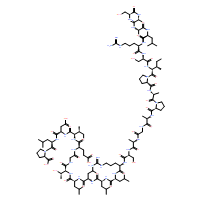| Description: |
Colivelin is a neuroprotective peptide and activator of STAT3. |
| Target: |
STAT3
Amyloid-β |
| In Vivo: |
Colivelin (intracerebroventricular administration; 10 pmol/3 μl; 3 weeks) suppresses impairment in spatial working memory induced by repetitive intracerebroventricular injection of Aβ25-35 or Aβ1-42, in addition, it antagonizes neuronal loss in the CA1 region of hippocampus induced by hippocampal injection of Aβ1-42[1]. Colivelin (intraperitoneal administration; 1.4, 7, or 35 nM/0.21 mL; on the Y-maze testday) suppresses memory impairment caused by 3-quinuclidinyl benzilateand restricts functional memory deficit[1]. Colivelin (intraperitoneal injection; 1 mg/kg; 14 days) results in improved motor and cognitive function with time by performance of mNSS, rotarod, and corner turning test.It also reduces lesion volume and improves neurological deficits after MCAO[3]. Animal Model: CD-1 mice[1] Dosage: 10 pmol/3 μl Administration: Intracerebroventricular administration Result: Completely suppressed Aβ 25-35-mediated impairment in spatial working memory and increased the number of immunoreactive neurons. Animal Model: C57 mice[1] Dosage: 1.4, 7, or 35 nM/0.21mL Administration: Intraperitoneal administration Result: Protected against cholinotoxin-induced amnesia in mice. Animal Model: Male C57BL/6 mice[3] Dosage: 1 mg/kg Administration: Intraperitoneal administration Result: Protected against ischemic brain injury, and improves neurological outcomes |
| In Vitro: |
Colivelin completely suppresses death induced by overexpressed FAD-causative genes and Aβ1-43 at a concentration of 100 fm, and keep its neuroprotective action at or above the levels of 1 nm[1]. Colivelin-induced neuroprotection occurs via two neuroprotective pathways: one mediated by Ca2+/calmodulin-dependent protein kinase IV, triggered by ADNF, and one mediated by signal transducer and activator of transcription 3, triggered by HN[1]. Colivelin reverses caspase3, Bax and Bcl-2 expressions in HT22 cells medaited by rmMFG-E8 in the co-cultured cells under OGD condition[4]. Colivelin (50 µg/mL, 4 hours) significantly increases the p-STAT3 protein levels in BV-2 cells[4]. Western Blot Analysis[4] Cell Line: BV-2 cells. Concentration: 50 µg/mL. Incubation Time: 4 hours. Result: Increased p-STAT3 levels. Cell Viability Assay[5] Cell Line: KYSE70 and TE8 cells. Concentration: 0.5 μM. Incubation Time: 1 hour (followed by CYT-Rx20 treatment) Result: Sgnificantly suppressed the viability in KYSE70 and TE8 cells. |
| References: |
[1]. Chiba T, et al. Development of a femtomolar-acting humanin derivative named colivelin by attaching activity-dependent neurotrophic factor to its N terminus: characterization of colivelin-mediated neuroprotection against Alzheimer's disease-relevant insults in vitro and in vivo. J Neurosci. 2005 Nov 2;25(44):10252-61.
[2]. Pan Z, et al. Upregulation of HSP72 attenuates tendon adhesion by regulating fibroblast proliferation and collagen production via blockade of the STAT3 signaling pathway.Cell Signal. 2020 Mar 18:109606.
[3]. Zhao H, et al. Colivelin Rescues Ischemic Neuron and Axons Involving JAK/STAT3 Signaling Pathway.Neuroscience. 2019 Sep 15;416:198-206.
[4]. Fang YY, et al. MFG-E8 alleviates oxygen-glucose deprivation-induced neuronal cell apoptosis by STAT3 regulating the selective polarization of microglia. Int J Neurosci. 2020 Mar 12:1-10.
[5]. Chiu WC, et al. The Synthetic β-Nitrostyrene Derivative CYT-Rx20 Inhibits Esophageal Tumor Growth and Metastasis via PI3K/AKT and STAT3 Pathways. PLoS One. 2016 Nov 22;11(11):e0166453. |






















